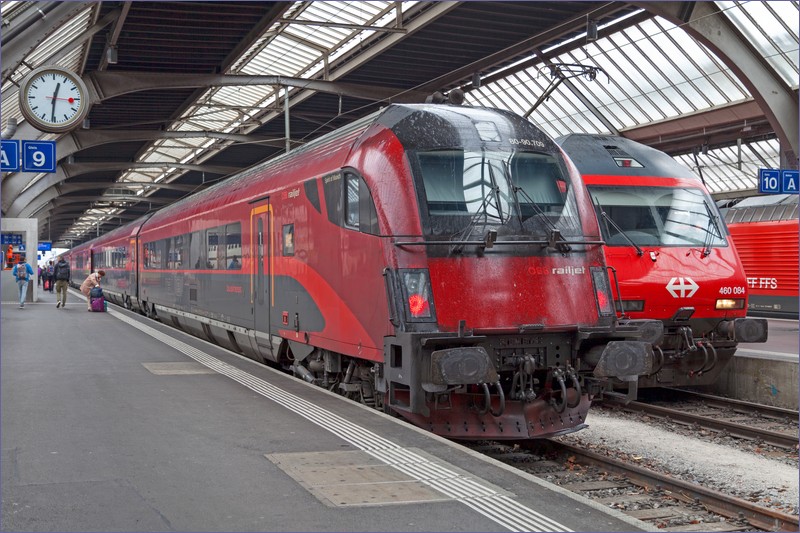Train travel in Switzerland is an excellent way to explore the country. Trains reach many popular destinations and are very well connected with buses. In Switzerland, there are a lot of tourist trains, including heritage railways. Railways in Switzerland are famous for their reliability, punctuality and scenic routes. The country has a dense railway network with more than 5,300 km length. Almost all railway network in Switzerland is electrified – except for the few tracks on which steam locomotives operate for tourism purposes only.
Note: In the future I will describe tourists railways in separate articles.
Last updated: 03.04.2024
Train travel in Switzerland – domestic trains
Trains in Switzerland are comfortable and connect all major cities and many popular tourist resorts. Noteworthy is its integration with other modes of transport – transfers from trains to buses, ferries and funiculars are very easy. Most of the trains is operated by Swiss Federal Railways (SBB CFF FFS), but there are many regional operators.
Tickets are very expensive. Fortunately, you can save a lot of money thanks to Interrail offers, and Swiss Travel System tickets for public transport throughout Switzerland and regional network passes.
Useful websites:
Swiss Federal Railways – official website. Timetable, tickets, prices.
Most popular domestic routes:
Zurich – St Gallen
Zurich – Geneva
Zurich – Basel
Zurich – Luzern
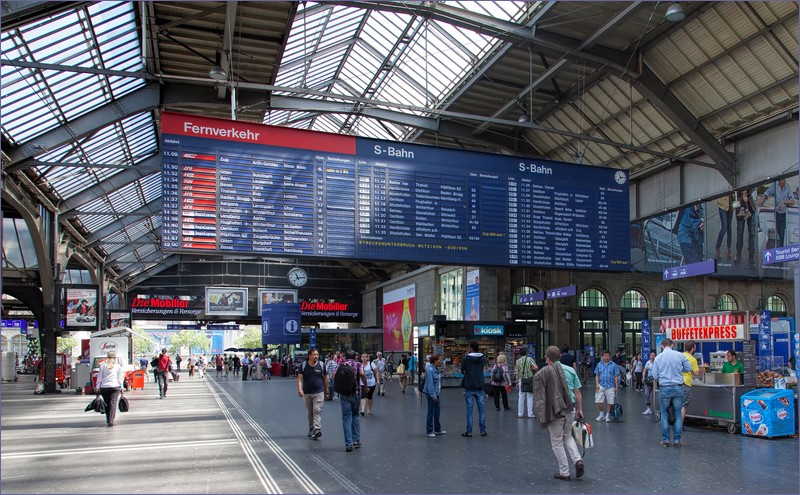
Train travel in Switzerland – Swiss Travel System
Swiss Travel System is an integrated public transportation network. Almost all Swiss carriers participate in the project, and schedules are arranged so that all connections are coordinated, meaning a train arrives at the station, and a bus is waiting at the station to transport passengers to their destination where the train does not reach. Single journey tickets are very expensive. Following network tickets were introduced allowing travel by all means of transportation based on one ticket.
Swiss Pass – the Swiss Pass is the best offer for train travel in Switzerland. It is a network ticket allowing the use of almost all means of transport – trains, buses, including urban transport, trams, ferries. Unlike the Interrail ticket, it is accepted by carriers operating panoramic trains (a mandatory reservation must be purchased).
There are several ticket options available on the market. It can be purchased online or through travel agencies and specialized portals (sometimes you will pay a high commission).
Most popular are tickets allowing to travel through Switzerland for 4, 8, 15, or 22 consecutive days within a month. The ticket allows to travel on all trains, buses, ferries, and urban transport in 41 Swiss cities. In addition, the ticket holder has free admission to over 480 Swiss museums and a 50% discount on cogwheel and cable railways leading to the highest peaks. Furthermore, the holder can use attractive discounts from program partners.
Swiss Saver Pass – for groups of two or more people traveling together. Each traveler receives a 15% discount on the ticket purchase, while retaining all the benefits of the Swiss Pass offer.
Swiss Youth Pass – a Swiss Pass for young people up to the age of 26. It provides the same rights as the Swiss Pass but cannot be purchased in the Saver option.
Swiss Flexi Pass – equivalent to the Swiss Pass offer, allowing travel on 3, 4, 5, or 6 selected days within a month. Apart from the days of validity chosen by the traveler, the ticket holder can travel on the remaining days with a 50% discount. Not available for individuals up to the age of 26.
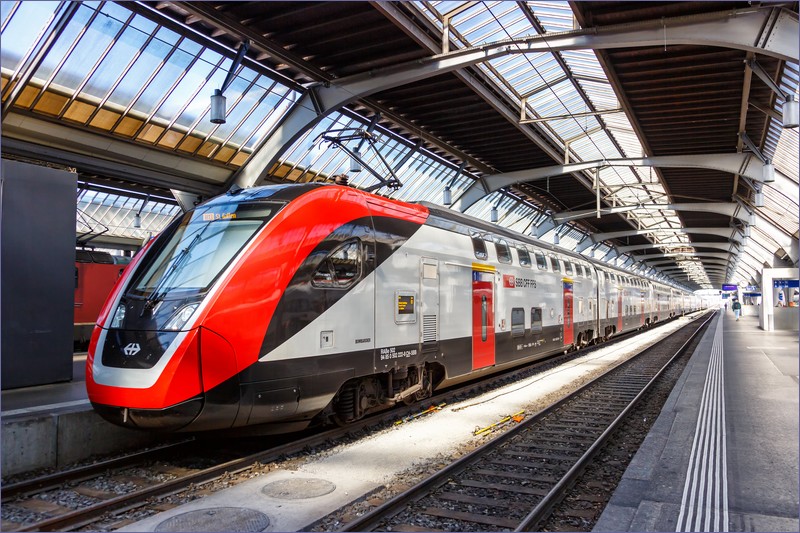
Rhaetian Railway
The Rhaetian Railway (Rhätische Bahn) is formally a local railway carrier in the Swiss canton of Graubünden. The company runs world-famous scenic trains Glacier Express and Bernina Express, which run on picturesque narrow-gauge mountain lines. The Rhaetian Railway is the longest metre-gauge railway in Switzerland, linking Arosa, Disentis, Davos, St. Moritz in the high Alps, and Tirano in Italy with Chur, a rail junction with the SBB. It passes through the upper Rhine Valley and several side valleys, as well as the Engadine, the upper valley of the river Inn. The Bernina Pass is the highest point on this line, at 2253 m. It is also the highest rail crossing in Europe. Total length of the route 366 kilometres.
Glacier Express
The Glacier Express is the slowest express train in the world. It runs daily between St. Moritz and Zermatt. Train covers the route of approximately 270 kilometers in 7 and half hours. The slow journey is rewarded with stunning views and a changing landscape outside the windows. During each trip, the train passes through 91 tunnels and 291 bridges. Tickets are not cheap, but it remains popular with travelers from around the world throughout the year. The Glacier Express is comprisef of air-conditioned, panoramic cars with very large windows and glass roofs. There is a dining car on each train. The highest station on the train route is Oberalppass at 2033 meters above sea level. Seat reservation is mandatory
The train is usually composed of a locomotive, two first-class cars, a dining car, and three second-class cars. The first-class car has 36 seats, one toilet, luggage racks, and seats arranged in a 2+1 configuration. Similarly, in the first-class car adapted for passengers with disabilities, there are only 30 seats. The second-class panoramic car is also equipped with one toilet and luggage racks. It can accommodate 48 passengers, with seats arranged in a 2+2 configuration.
A significant downside of the Glacier Express is the seating arrangement. Passengers sit facing each other. While the beautiful views compensate for this, those sitting by the aisle are not as close to the window to take photos. Moreover, the windows cannot be opened, and anyone who has tried taking photos through the glass knows how it ends. Therefore, many people recommend traveling the route by regular regional trains. The views are the same, the prices are much lower, and there are often fewer people in the carriages.
Glacier Express – official website
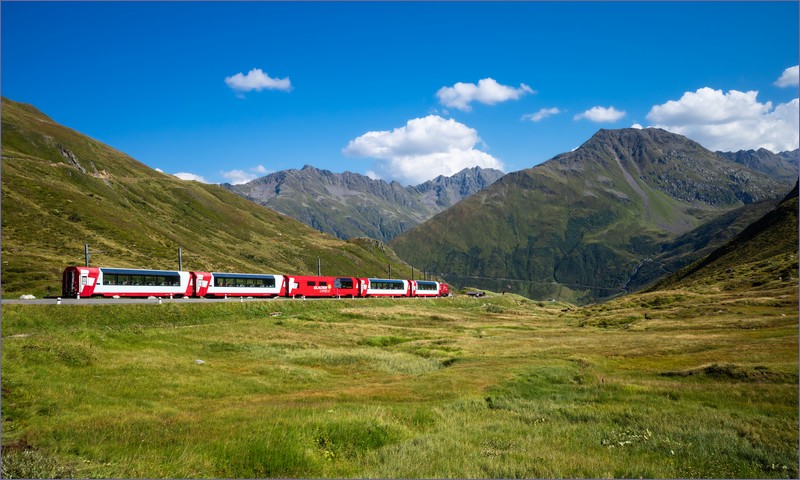
Bernina Express
Very popular express train comprised of panoramic cars. It connects the Swiss town of Chur with the Italian town of Tirano, where a special bus can take passengers to Lugano (additional fee required).
The train crosses the Alps, accompanied by changing kaleidoscope-like landscapes. Mountains, glaciers, lakes – everything can be seen during the journey on this train. Passengers can listen to information about the places they pass through via headphones. The highest point – Ospizio Bernina – is located at an altitude of 2253 meters above sea level. During the four-hour journey the train passes through 196 bridges and 55 tunnels. Total length of the route is 145 kilometers. Seat reservation is mandatory.
The Bernina Express runs several times a day. Traveling by this train is an interesting option for those who have chosen Milan for a weekend trip by budget airline. From Bergamo airport, it is easy to reach Milan, and from Milan, regional trains often run to Tirano. These trains are operated by Italian regional carrier Trenord.
Rhaetian Railway – official website
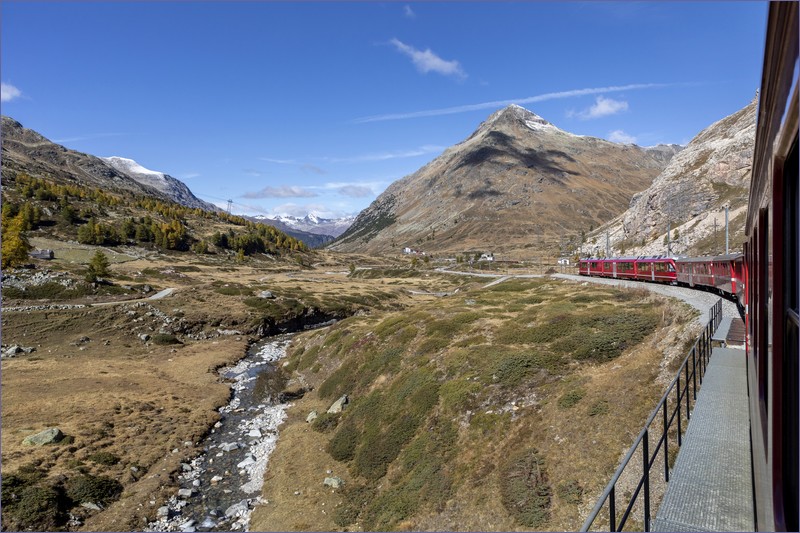
Train travel in Switzerland – integrated tariff systems
In many cantons of Switzerland, integrated tariff systems have been in operation for a long time, allowing travelers to use trains and other public transportation with a single ticket within the canton. In addition to single journey tickets, tourists can purchase daily and group tickets. The general conditions for these tickets and zone divisions are complex and difficult to understand for someone who does not live or often travel in Switzerland, so I will provide only brief descriptions of the most important integrated tariff systems along with links to official websites, where they are described in detail, often only in German, French, or Italian. Tickets can be purchased at ticket counters, ticket machines, online, through smartphone apps, and as a last resort, from drivers.
Typically, tariff conditions are as follows: children under the age of 6 travel for free; children aged 6 to 16 pay half the ticket price. Holders of Swiss railway discount cards are entitled to a 50% discount. In many cases, it is possible to purchase additional tickets for transporting bicycles or animals. Travel class – first or second – can also be chosen.
NOTE: It is impossible to follow up-to-date information about these offers. Terms of the offers may change in the future – always check official websites before your trip.
Arcobaleno – an integrated tariff system of the Ticino canton and the Moesa district in Graubünden for various modes of public transportation: trains, buses, mountain railways, and selected ferries. There is a complex zone division – different for single journey and period tickets. For holders of single journey tickets, as many as 49 three-digit zones have been designated, while for holders of period tickets, only 16 (two-digit designation) have been allocated. Regarding railway carriers, the ticket is valid on Swiss railway trains, Treni Regionali Ticino Lombardia (only within Swiss territory – a separate ticket must be purchased for the Italian section; a special cross-border tariff also applies), and Ferrovie Luganesi (Lugano – Ponte Tresa line; the train reaches the Swiss part of the divided city).
A daily ticket “Carta giornaliera” is available, but only for a few validity zones – from one to eight. It is also possible to purchase a six-day ticket at the price of five daily tickets (Multi carta giornaliera). Six days of travel can be used within 3 years.
Arcobaleno – official website. Prices and maps.
Libero – an integrated tariff system of the Bern, Solothurn, and Biel cantons. The offer is similar to the previously described ones, with a complex zone division and many downloadable maps, making it very difficult to understand for people unfamiliar with the realities of integrated tariff systems in Switzerland. Daily tickets are available for selected zones (from 1 to 15 zones) or for more than 15 zones, theoretically covering all zones except green zones (marked on the map). A six-day ticket costs the same as six daily tickets.
Libero – official website. Prices and maps.
Mobilis – an integrated tariff system of the Vaud canton, covering Lausanne and its surroundings. There are many zones, and daily tickets available, valid from 00:00 on the indicated day of ticket validity until 05:00 the next day – it is possible to purchase a daily ticket for a specific zone or for all zones. In addition to the integrated tariff system, tourists in some accommodation facilities receive or can purchase cards entitling them to free travel in designated zones around the most popular cities and resorts (Lausanne Transport Card, Montreux Riviera Card, Lavaux Transport Card, Valpass).
Mobilis – official website
Onde – an integrated tariff system of the Neuchâtel canton and individual districts in the Bern and Jura cantons. A 24-hour ticket (Carte 24 heures) is also available, but only for up to 10 zones, i.e., not for the entire tariff system area.
Onde – official website
Ostwind – an integrated tariff system accepted by 31 carriers in northeastern Switzerland (railways, buses, mountain railways, mountain railways, and ferries) and in Liechtenstein (only buses). The area of the participating cantons in the Ostwind system is theoretically divided into 13 zones (there are many more zones on the zone map), and offers include daily tickets (Tageskarte) valid from 00:00 on the indicated day of validity until 05:00 the next day. These tickets can be purchased for a specific zone.
Ostwind – official website
Passepartout – an integrated tariff system of the Lucerne, Obwalden, and Nidwalden cantons, with 12 carriers participating, including four railway carriers: Swiss Railways (SBB CFF FSS), BLS, Passepartout, and Zentralbahn. Similarly to other regional integrated tariff systems, the division into zones is difficult to understand for tourists. Daily tickets are available for selected zones (from 1 to 10 validity zones) or for all zones. The daily ticket is valid from 00:00 on the indicated day of validity until 05:00 the next day, with an additional fee required for night trains operated by SBB. A Multi-Tageskarte six-day ticket can also be purchased.
Passepartout – official website
TNW – an integrated tariff system of northwestern Switzerland, covers the cantons of Basel-City, Basel-Landschaft, Fricktal, and several other municipalities. Five carriers is participating in the off. Available tickets for one, two, and seven days cover the area of the so-called Greater Basel or the entire TNW network. Tickets are valid only within the territory of Switzerland.
TNW – official website
Unireso – an integrated tariff system of the Geneva canton. Unlike other offers, there is no need to worry about zone division – the Geneva canton is zone 10, and after the other Swiss and French zones marked on the maps, you can travel with a Leman Pass ticket described in the above section. One-day ticket is available, valid from 00:00 or 09:00 until 05:00 the next day. On Saturdays and Sundays, two people can travel on a one-day ticket valid from 00:00 in second class (this may change – please check the official website).
Unireso – official website
ZVV – an integrated tariff system in Zurich and its region – divided into zones. For tourists, the 9 O’Clock offer is available – a ticket entitling to unlimited travel within the ticket’s validity area from 09:00 on the day specified as the validity date until 05:00 the next day. This restriction applies from Monday to Friday; on Saturdays, Sundays, and public holidays, the ticket is valid all day. The 9 O’Clock ticket is valid in all zones of the ZVV system; however, those wishing to travel on night lines must pay an additional fee. A six-day version is also available for purchase.
ZVV – official website
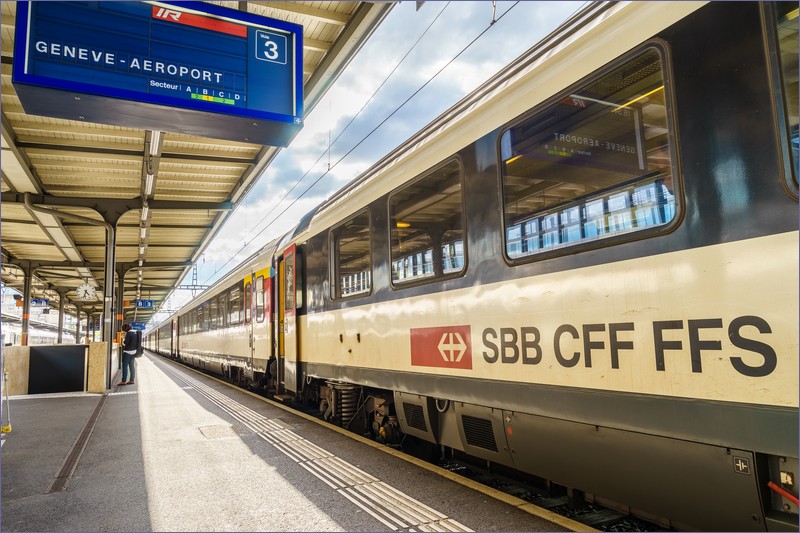
Train travel in Switzerland – international trains
Switzerland has many international train connections and many regional cross-border network passes. In the future, I will write extensive articles about trains between Switzerland and other countries.
Austria
There are Railjet trains from Vienna to Zurich and an overnight train between the capitals of Austria and Switzerland.
Tickets can be purchased on shop.oebbtickets.at website.
Croatia, Slovenia
There is an overnight train from Zurich to Zagreb with stop in Ljubljana, Slovenia.
France
Numerous long-distance and regional trains. There are TGV Lyria trains, for which you can buy tickets at a promotional rate, but based ticket prices are very expensive, as well as local trains from Geneva, on which you can travel under the cross-border integrated fare system, including Lemon Pass one-day ticket.
Germany
Numerous long-distance connections from various parts of the country, such as Hamburg – Basel, Munich – Zurich. Regional connections include Schaffhausen – Singen, Basel – Zell.
Italy
There are direct high-speed trains between Milan, Zurich and Basel. Some connections are served by the modern Giruno trains of the Swiss railways, while others are operated by Italian trains designed for Frecciabianca, Frecciarossa, and Frecciargenta trains.
From Milan, you can also reach Geneva by Eurocity train.
Some trains from Zurich also continue to Bologna, Genoa, and Venice.
Trenitalia – search engine, online shop, additional information
The narrow-gauge railway, 52 kilometers long, connects the Italian Domodossola with the Swiss Locarno. One of the most beautiful European railway lines is partially located in Italy and partially in Switzerland.
Domodossola – Locarno trains – official website
The famous Bernina Express trains of the Rhaetian Railway start their journey from the Italian town of Tirano. To reach Tirano from the heart of Italy, you need to take Trenord trains.
There also direct trains or carriages from Zurich to Prague, Amsterdam and Budapest.
Related articles:
